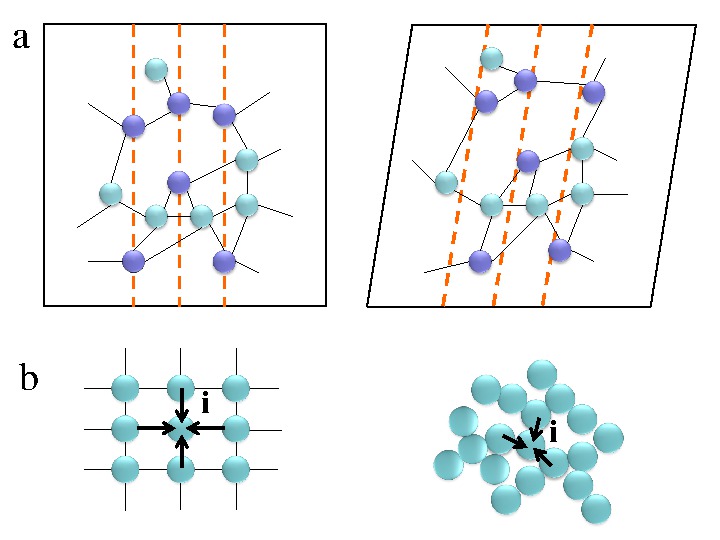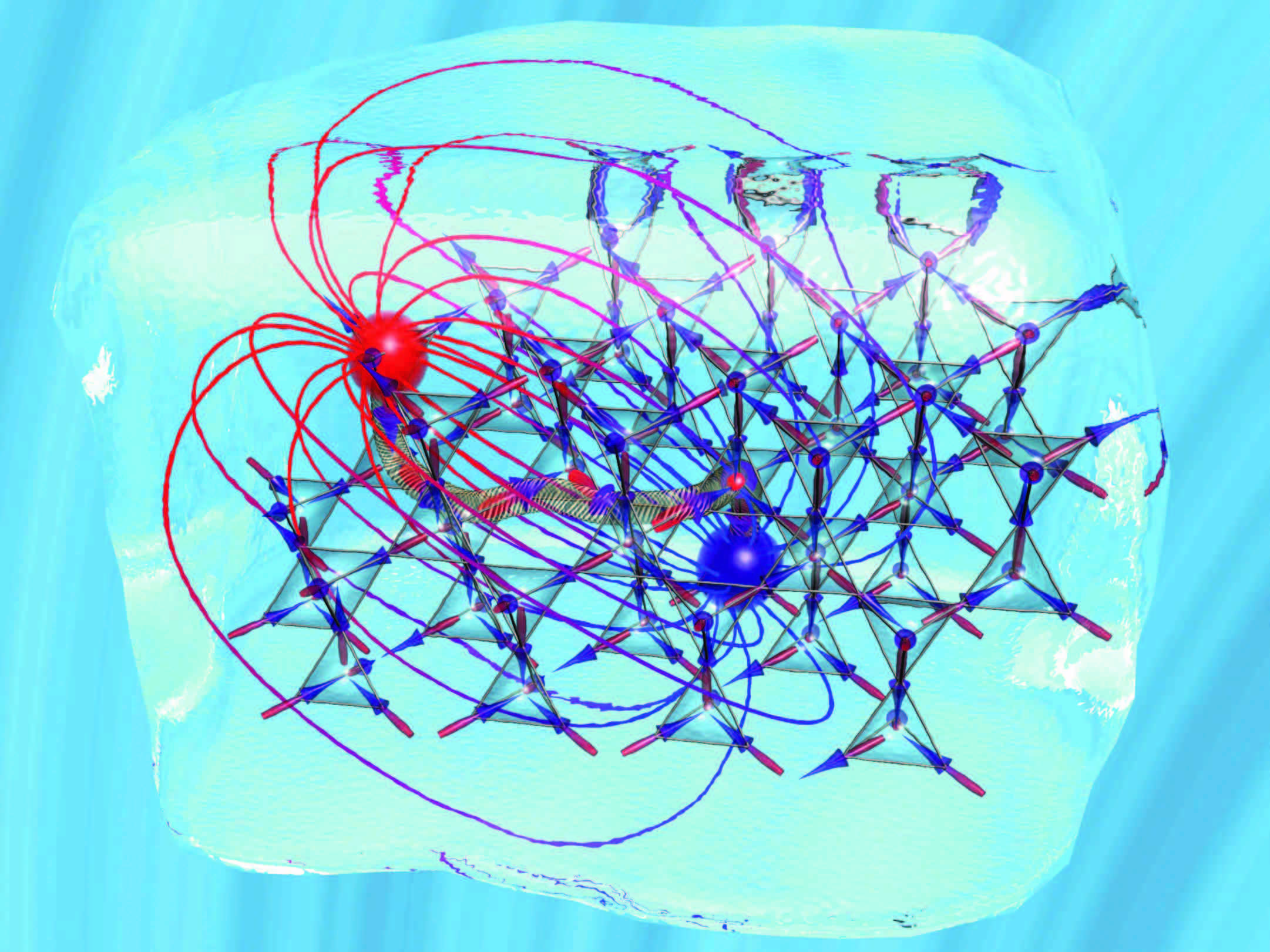Statistical Mechanics
The research interests in Statistical Mechanics in the TCM group are primarily concerned with emergence and far from equilibrium behaviour in many body classical systems. Specific research topics include:
Dr Claudio Castelnovo
Theory of Condensed Matter Group.
Prof. Eugene Terentjev
Biological and Soft Solids Sector
Dr Alessio Zaccone
Theory of Condensed Matter Group.
We hold regular group meetings together with the Collective Quantum Phenomena and Soft Condensed Matter Physics group.
Theory of amorphous materials

(a) The concept of nonaffine deformation in amorphous solids. If the deformation was affine, the particles labeled with darker color would still lie on the dashed lines also in the deformed (rightmost) frame. Because of nonaffinity, they do not. (b), In an ordered crystal lattice (left) the forces (arrows) transmitted to any particle i by its nearest neighbors upon deformation cancel each other and the net force acting on i is zero by symmetry. In a disordered lattice (right) the forces transmitted upon deformation do not balance, and a net non-zero force acts on i which has to be balanced by an additional (nonaffine) motion, to further lower the lattice potential energy in order to preserve the mechanical equilibrium. The nonaffine motion is visible in panel (a).
The origin of glassiness
Whereas melted silicon oxide is a liquid not dissimilar from water, it is well-known that the time scales to form quartz crystals are vastly larger than those to form water ice. What happens to silicon oxide instead is that it becomes a glass: a state of matter that is microscopically indistinguishable from a liquid, yet it exhibits macroscopic properties that are characteristic of a solid (e.g., shear) due to the fact that flow takes place on extremely long time scales. The concept of glassiness has come to encompass a broad range of phenomena where the response and relaxation time scales grow abnormally with respect to what one could naively expext from the microscopic constituents of the system.
The origin of glassiness and of a possible glass transition in real systems are in great part still a mistery, listed by P.W.Anderson as one of the great challenges of modern day physics.
Dynamics and kinetics of Brownian systems
Particles in the size range between a few nanometers and a few microns suspended in a liquid exhibit a peculiar type of dynamics called Brownian motion whereby they move randomly in the environment under the influence of many microscopic collisions with the solvent molecules. In many systems of both practical (e.g. nanotechnology) and biological (e.g. proteins) interest, Brownian motion plays a role in conjunction with other types of forces such as hydrodynamics (e.g. shear flow), electrostatic and dispersion forces, osmotic forces etc. The interplay of all these forces controls the aggregation and phase behaviour of colloidal systems which is reflected in the evolution of the macroscopic properties (e.g. rheology, optical properties etc). By working with diffusion-type Fokker-Planck equations we aim at incorporating this complexity into a unifying framework that can be used to rationalize the phase behaviour, macroscopic properties and phase transitions of colloidal systems such as nanoparticle and protein suspensions. This project is in close collaboration with several experimental groups, including Dr E Eiser (BSS) and Prof A Donald (BSS) as well as other groups in Germany and Switzerland.
Frustrated Magnetism

Pictorial representation of a monopole-antimonopole pair in spin ice [Artist: A.Canossa].
Frustration indicates the inability of a system to reach its lowest energy state where all interaction terms are simultaneously minimised. In magnetism, frustration prevents the formation of ferro- or antiferromagnetically ordered phases at low temperature, thus allowing the emergence of new phases that often escape a conventional description in terms of local order parameters. Frustration is also at the core of paradigmatic non-equilibrium systems such as spin glasses.
A class of frustrated magnetic models and materials that received much attention of late is that of spin ices (e.g., Dy2Ti2O7, Ho2Ti2O7). In these systems, the competition between lattice structure, crystal electric fields, and interactions leads to an extensively degenerate ground state whose magnetic correlations are aking to the positional correlations of proton in (cubic) water ice, hence the name spin ice. Whilst disorder (namely, non-zero entropy) survives down to very low temperatures, these systems are far from trivial: the correlations indeed lead to the emergence of a gauge symmetry -- much like the one observed in a free magnetostatic field -- and the collective excitations take the form of magnetic monopoles! In a rare instance of fractionalisation in three dimensions, spin ice materials provide the first experimental avenue to probe and manipulate free magnetic charges. This research was awarded the 2012 Europhysics Prize and even featured in an episode of the sit-com "The Big Bang Theory" (S03E09).Dimer, Colouring, and Vertex Models
In order to understand the behaviour of many body systems, it is sometimes useful to introduce effective degrees of freedom which are well-defined at least in some region of parameter space. For instance, electrons on a lattice where the largest energy scale favours the formation of nearest-neighbour valence bond singlets may be described by an effective model of fully-packed dimers on the bonds of the lattice at temperature smaller than the pairing energy scale. Similarly, systems that give rise to ice rules at low temperature (see above) are captured by appropriate vertex models; and p-wave superconducting islands forming a triangular lattice with Josephson junctions across their edges can be described by a three-colouring model.
At the classical level, these constrained systems offer a rich playground for exotic behaviour, both in their thermodynamic as well as dynamical properties, and are at times amenable to exact calculations.